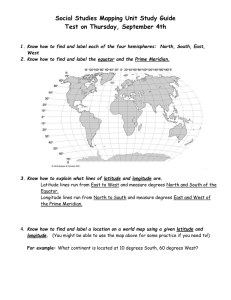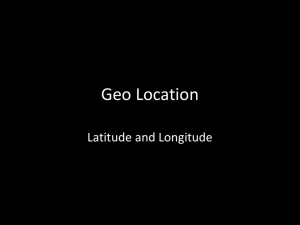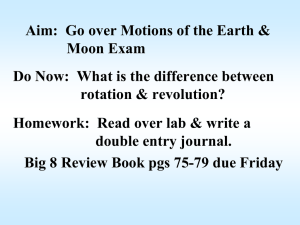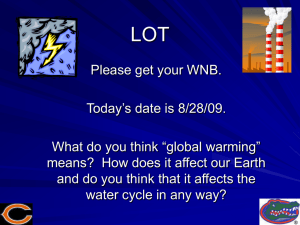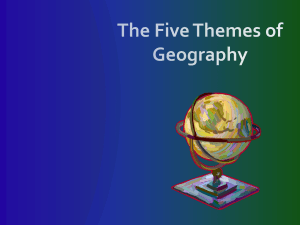Globe to map Practical Vector GIS 1
advertisement
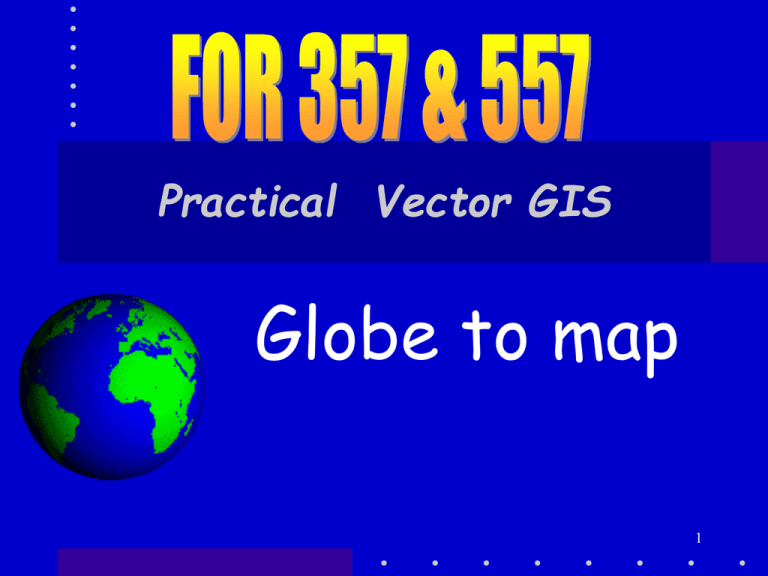
Practical Vector GIS Globe to map 1 The where is it… • How do we locate Syracuse in space on the earth’s surface? • On a FLAT surface? 2 The where is it… • How do we locate Syracuse in space on the earth’s surface? • On a FLAT surface? 3 -76.19 degrees west of meridian through Greenwich, England 43.07 degrees N of the equator How do we locate Syracuse on earth? 4 43.07 degrees N of the equator -76.19 degrees west of meridian through Greenwich, England 5 Earth’s Coordinate System North Pole Lat = 30º Long = -6 0º Lat = 0º Lat = -30º South Pole X is Longitude and is measured E and W from Greenwich, England. West is negative, East is positive Y is latitude and is measured N and S from the equator. North is positive and S is negative. These are called Geographic Coordinates 6 Coordinates on Earth North Pole Meridians Longitude Equator Parallels Latitude South Pole 7 X, Y = Longitude, Latitude 90 60 30 0 -30 -60 -90 -90Stretch the 0 bottom +90 +180 Lines of constant Longitude Lines of constant Latitude Stretch the top Equator -180 8 X, Y = Longitude, Latitude 90E, 30N Equator 90W, 30S -180 +90, +3090 60 30 0 -30 -60 -90 -30 -90 -90 0 +90 +180 Lines of constant Longitude Lines of constant Latitude 9 The world in Geographic Coordinates Is Antarctica Really that big? 10 The where is it… • How do we locate Syracuse in space on the earth’s surface? • On a FLAT surface? 11 The where is it… • How do we locate Syracuse in space on the earth’s surface? • On a FLAT surface? • What we just did, plot Long, Lat coordinates, put the globe on a flat surface but DISTORTION • Why distorted? 12 13 14 15 16 Maps are Flat • The globe is an ideal model of the earth (almost) • But you can’t put a useful one in your pocket usless • So the problem is to put data from a sphere (almost) onto a flat surface • Xerox can’t do it 17 Overview 1. There are a number of problems that apply when converting to flat maps • Geographic coordinate systems • • • • #1 #2 #3 #4 problem problem problem problem – – – – Datums Projection Scale Generalization 2. Here they are, 1 by 1 18 Problem #1, Datums • Earth is NOT a sphere! • It is more pear shaped • To accommodate this geographers and surveyors have created models of the earth’s surface • These are called Datums • And this is booby trap #1 because… • Different shapes different coordinates 19 Trees Don’t Move Much • But their coordinates can change • The Long/Lat of this tree will be different depending on which datum is being used! • Could be up to ~50m different in the US • There are lots of different datums to contend with! 20 Problem #2 21 Mercator 22 The Projection Problem • There are many mathematical ways of projecting the spherical surface onto a flat surface. • For the earth these have names like Albers equal area Mercator Albers Peters Polyconic Lambert equal area Azimuthal 23 Other Projections Wrong Question – they are all right, just different. And they all have different properties 24 Problem #3 Geographic SCALE 25 Definition Scale = distance on map(distance unit) distance on ground (distance unit) A Scale of 1/24,000 means 1 inch (or foot, or furlong) on the map = 24,000 inches (or feet or furlongs) on the ground. 26 3.5” 2,600 Mi Numeric or Ratio scale =1/47,067,429 27 2.6” / 25’ Scale = 1/115 Living Room Dining Room Kitchen 28 Scale 1/47,000,000 =0.000000021 Is a smaller number than Small Scale data Large area/sheet Least accurate 1/46,000 =0.000022 Is a smaller number than Living Room Dinning Rm. Kitchen 1/115 =0.008696 Large Scale data Small area / sheet Most accurate 29 Scale 1/47,000,000 =0.000000021 Is a smaller number than Small Scale data Large area/sheet Least accurate 1/46,000 =0.000022 Is a smaller number than Living Room Dinning Rm. Kitchen 1/115 8888 =0.008696 Large Scale data Small area / sheet Most accurate 30 Problem #4 -Accuracy & Generalization • When a paper map is made at a very small scale the cartographer is limited by the pen being used • Can’t draw anything finer than the width of the pen line. • At a scale of 1/1,000,000 a line 0.05 cm wide = 0.05x1,000,000 cm or 50,000 cm or 500 meters or 19,850” or 1,640’ wide! • What road is 1,640’ wide!!! • So on the map the road is much, much too wide 31 Accuracy & Generalization • Take the case of a winding stream • Shrink it to a Smaller scale (large area, small paper • Now it is hard to see what is there • So the cartographer simplifies the stream 32 Accuracy & Generalization • The generalized stream is not as accurate a representation of the stream as the original • And if you try to mix data of different scale common lines are NOT going to match Original Generalized 33 Booby Trap Summary • Using a GIS is more than just combining various data layers – just knowing what buttons to push is NOT sufficient!!! • You have to be careful that the basic 4 booby traps outlined above do not cause problems • And 4 possible sources of error give Murphy a field day since problems encountered go up as n2 34 Booby Trap Summary • Using a GIS is more than just combining various data layers •Datum • You have to be careful that the basic three booby traps outlined here do •Projection not cause problems • And 3 possible sources of error give •Scale Murphy a field day since problems encountered go up as n2 •Generalization 35 And that was just this! iceberg This topic will be a major part of the course! 36
